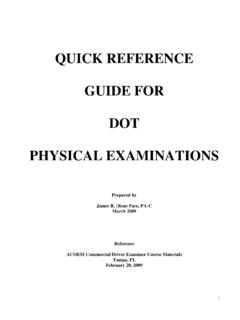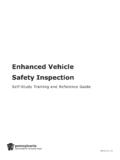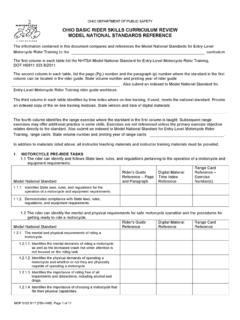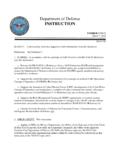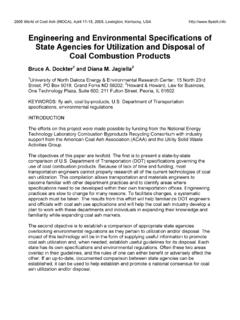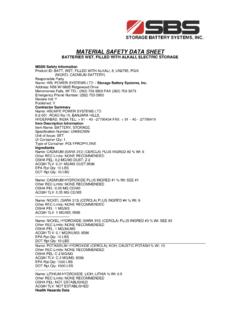Transcription of Connecticut DOT
1 Connecticut DOT. 2017 Cost Estimating Guidelines I. PURPOSE. These guidelines provide basic cost estimating information for Department construction projects and recent cost information for several common construction items. These guidelines do not provide guidance on estimating preconstruction (engineering design). costs. An explanation of construction cost elements follows. II. GENERAL. The Department's cost estimating process is heavily reliant on AASHTOWare Project Estimator (Estimator ) a widely-used software adapted specifically for Department use. The CTDOT AASHTOWare Project Estimator Procedures Guide provides detailed guidance on using the software for Department projects and should be referenced in conjunction with these guidelines.
2 Total project cost includes pre-construction and construction phase expenditures. The following is a general framework of project costs: PRECONSTRUCTION. o Project planning, o Design (State or consultant), o Design management, liaison and review/support (Department units), o Permit application preparation, o Engineering by utilities and municipalities, and o Right of Way appraisal, acquisition and relocations. CONSTRUCTION. o Contract, o Non-contract, Construction inspection and contract administration (materials testing, design support), Work and inspection by utilities and municipalities, Work and inspection by railroads, and State Police. o Contingency (generally added separately to Contract and Non-contract costs).
3 In addition to the above, other project-related costs ( , adjustment of traffic signals by state forces) are sometimes incurred. An example estimate covering various phases and cost categories is provided as Attachment 1. 1. Connecticut DOT. 2017 Cost Estimating Guidelines CONTRACT ITEMS are the individual pay items performed by the Department's contractor. During the bidding process, bidders submit prices for unit-based ( , paid for by cubic yard, each, ton, linear foot, etc.) and lump sum items. Some contracts also include one or more Estimated amount (EST) items. For these items, the Department designates the contract amount, generally because the required work is not sufficiently defined to solicit binding bids.
4 The established amount is included on the bid proposal form and part of each bidder's bid amount. The actual amount paid for an Estimated amount item is determined during construction based on actual requirements. Estimator is the principal tool used to estimate contract unit-based items. Much of the procedural detail associated with using Estimator is provided in the CTDOT. AASHTOWare Project Estimator Procedures Guide. Estimator has several limitations, including: It does not generate estimated prices for lump sum or Estimated (EST) items. It does not generate estimated non-contract costs ( , utilities, state police). It does not generate estimated prices for unit-based items unless the item was used in at least two previous construction contracts within the selected catalog.
5 If the selected bid history catalog has between 2 and 14 occurrences of the same item, the Estimator price will be the average of those prices. No project-specific factors are accounted for. If the selected bid history catalog includes 15 or more occurrences of the same item, the Estimator price will be a regression on several factors (quantity, location, letting date, work type). However, other factors affecting bidder prices ( , schedule constraints, difficult site conditions) are not accounted for. Because of these limitations, the estimator needs to prepare some prices using other information. Additionally, sometimes the estimator should override the price generated by Estimator.
6 NON-CONTRACT ITEMS represent Department expenses for work required to complete the project but not included in the contract. Specific elements comprising this category are discussed below. Incidentals the cost of Construction Engineering (CENG), which consists of the various activities required to administer the construction contract, including inspection, materials testing, construction phase design support and other functions. It includes state and consultant forces, when applicable. For state- awarded construction contracts, this Incidental Cost is estimated using a sliding scale percentage of the contract cost in accordance with a Chief Engineer's memorandum (dated January 10, 2014), provided as Attachment 2.
7 Include the estimated amount in the Estimator file. For contracts awarded by local public agencies, refer to the Chief Engineer's memorandum dated August 14, 2009. (Attachment 3). 2. Connecticut DOT. 2017 Cost Estimating Guidelines Utility Agreements and Railroad Relocation and Protection the cost to the Department by public utilities and railroads required by the project, such as for relocation of public utilities or interference with railroads (by physical alteration or occupation of their property). During project development, written agreements between the Department and each affected utility and railroad are developed and executed to cover the estimated cost of relocation and protection.
8 The Department's share of the cost is governed by State statute, as summarized in the Utility Manual for Documenting and Billing Highway Relocation Work (Exhibit 1-1). The Utilities Section of the Division of Facilities and Transit will, upon request, prepare estimated utility costs during project development; that unit also coordinates preparation and execution of utility agreements. Beginning with the Preliminary Design (or Rehabilitation Study Report) submission, the lead design unit should request an estimate of the State's share of utility relocation costs, in addition to comments, from the Utilities Section at milestone submissions. The estimated State share of utility relocations should be included in the total estimated construction cost.
9 At FDP, this amount is included in the Estimator . file as a non-contract cost. State Police dedicated State Police patrol and traffic control are used for selected projects, primarily involving work on limited access highways and ramps. The Division of Traffic Engineering (for State designed projects) or consultant (for consultant designs), in consultation with District Construction, determines which projects require dedicated State Police. When its need is anticipated, the lead design unit should include this item in the cost estimate. For projects designed by Department design units, the Division of Traffic Engineering will, upon request, provide an estimated State Police cost.
10 For consultant designed projects, the consultant should make an estimate; the Division of Traffic Engineering will comment on the estimate as part of design milestone reviews. The cost of State Police is attributable to the project but is not a contract item or cost. The cost is paid by the Department through an interagency Memorandum of Understanding. The estimated amount should be included in the total estimated construction cost. At FDP, this amount is included in the Estimator file as a non-contract cost. Estimator (software) provides no assistance in estimating the three cost categories noted above. The estimated costs for these items should be developed offline' and entered into Estimator.










